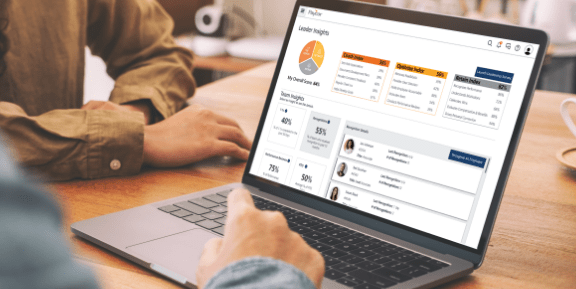How’s it possible that only 12% of employees strongly agree their organization does a great job onboarding new employees?
Here’s the problem: onboarding requires both high-touch human connection (new hires need to feel welcomed) and heavy-lifting administrative work that comes with compliance requirements. When HR tries to juggle all of this manually, something’s got to give. And usually, it’s the human connection that gets skipped.
Without automation, onboarding becomes a scramble of missed deadlines, forgotten tasks, and new hires who feel like an afterthought. But here’s what companies are realizing: onboarding automation isn’t about replacing the human element — it’s about making space for it.
What is Onboarding Automation?
Using the technology at its disposal, onboarding automation simplifies the process of bringing on new employees. Instead of a stack of paperwork and manual data entry, it automates tasks and centralizes everything in a single, user-friendly platform.
When a new hire accepts an offer, the automated process kick-starts by sending welcome emails, creating employee records, notifying IT to order equipment, scheduling orientations, assigning training modules, and tracking progress — all without anyone having to remember to do it.
Onboarding Automation Benefits
There are many advantages to be gained from onboarding automation by employees and employers.
For Employees
New hires want two things: to feel welcomed and to get up to speed quickly. Automation helps:
- Create consistency: Every employee gets the full onboarding experience, not just whoever happens to start when HR isn’t completely swamped.
- Speed things up: No more waiting a week for login credentials or wondering when their training starts
- Reduce confusion: Clear checklists and timely reminders mean they always know what’s next
- Enable real connection: When managers aren’t buried in paperwork, they actually have time to sit down and talk about expectations, goals, and how the new hire can contribute
For Employers
The business case for automation is pretty straightforward and involves:
- Saving time: HR teams get hours back in their day instead of chasing down missing forms and coordinating between departments
- Making fewer mistakes: No more typos in employee records, missed compliance deadlines, or forgotten equipment orders
- Bettering retention: Companies with solid onboarding improve retention by 82% and productivity by 70% (Devlin Peck)
- Gaining visibility on process: Know exactly where each new hire stands without sending a dozen “just checking in” emails
- Saving money: Less time on administrative tasks means more time for strategic HR work that actually moves the needle
How Does the Onboarding Automation Process Work?
Picture your current onboarding process. Someone accepts an offer, and then what happens? If you’re like most companies, it triggers a flurry of manual tasks — emails to IT, paperwork to the new hire, calendar invites for orientation, reminders to managers, and so on.
Automated onboarding replaces that manual scramble with a smooth, trigger-based system. Here’s what gets automated:
- Document collection: I-9s, W-4s, company policies, benefits enrollment—all handled digitally with e-signatures
- System provisioning: Employee records created automatically, access permissions set up, accounts activated
- Task management: Assignments distributed with automatic reminders and progress tracking
- Communication sequences: Welcome emails, pre-boarding information, and check-in messages sent at the right time
- Training enrollment: New hires automatically registered for required courses with progress monitoring
- Equipment coordination: IT orders triggered, workspace setup scheduled, security badges processed
- Compliance tracking: Requirements monitored, deadlines tracked, reports generated automatically
Each piece connects to the next. When a new hire completes their tax forms online, the system automatically files them, checks them off the list, and triggers whatever needs to happen next. No manual handoffs, no dropped balls, no wondering if something got missed.
How to Automate the Onboarding Process Step by Step
Ready to automate your onboarding but not sure where to start? Here’s how to choose the right approach:
Step 1: Map Your Current Ecosystem
Before you automate anything, understand what you’re working with. Map out every step from offer acceptance to the end of the first month, but also inventory your existing tools—what systems do you already use and love? Which third-party apps are essential to your business? Also consider your hiring patterns: do you onboard people one at a time, or do you sometimes need to bring in large groups at once? Understanding your current ecosystem helps you identify what you’re missing, like opportunities for hiring tax credits that might be slipping through the cracks.
Step 2: Prioritize Integration Over Replacement
Here’s what most companies get wrong: they pick a tool first, then try to make it work with their existing systems. Do it backwards. Look for solutions that are built to integrate and partner with the tools you already have.
The best platforms don’t force you to rip and replace everything—they connect with your ATS, payroll system, benefits platforms, and even specialized tools you might use for specific departments. You want seamless coordination between all your systems, not more manual handoffs.
Step 3: Plan for Flexibility and Growth
The fanciest automation in the world is useless if people don’t use it or if it can’t evolve with your business. Look for platforms that are intuitive enough that busy managers will adopt them, but also flexible enough to grow with your needs.
Hiring managers need clear task lists and the ability to assign and track responsibilities throughout the entire process — from pre-hire activities to post-hire follow-ups. Can you easily add new integrations? Access new solutions through a partner marketplace? Scale up without starting over?
If not, plan for where your business is heading, not just where it is today.
Step 4: Choose Unified Platforms
Don’t try to cobble together five different point solutions. Look for a comprehensive HCM software that handles onboarding as part of a broader talent management system, but make sure they’re open enough to work with your existing tech stack.
The ideal onboarding automation solution includes built-in workflows, document management, and e-signatures, while also offering access to a marketplace of additional solutions when you need specialized functionality. Pay attention to platforms that can handle bulk actions — if you’re hiring seasonal workers or expanding teams, you need systems that can efficiently onboard large groups without multiplying your workload.
Best Practices for Automated Employee Onboarding
Don’t wait until someone’s first day to begin the onboarding process. Start early and include these other steps to ensure the full experience.
Start Before Day One
Use automation to kick things off the moment they accept your offer. Send welcome messages, handle paperwork digitally, and let them know what to expect. This pre-boarding approach keeps excitement high and reduces first-day jitters.
Build in Flexibility
Not everyone follows the same path. Your sales team needs different onboarding than your engineers. Remote employees need different support than office workers. Make sure your automation includes personalization to handle these differences without creating completely separate processes.
Keep Content Current
Nothing undermines automated onboarding faster than outdated information. That link to the benefits portal that changed six months ago? New hires will find it. So, set up regular content reviews and assign someone to own this process.
Balance Automation with Human Touch
Use automation to handle the logistics so humans can focus on relationships. Let technology manage paperwork, scheduling, and task tracking. Save human time for explaining company culture, answering questions, and helping new hires understand how they fit into the team.
Importance of Onboarding Automation and Human Interaction
Here’s something crucial to understand: managers account for 70% of variance in employee engagement (Gallup). No amount of automation can replace a manager who takes time to properly welcome a new team member. But when managers are drowning in administrative tasks, guess what gets skipped? The welcome conversation.
When the system handles form completion, system access, and compliance tracking, managers can focus on setting expectations, explaining team dynamics, and helping new hires understand what success looks like in their role.
The magic happens when new hires get both efficient processing and genuine human connection. They’re not frustrated by delays or confused by missing information, and they’re not treated like just another number in the system. That’s when onboarding actually works.
Automate Employee Onboarding with Paycor
Ready to stop drowning in onboarding paperwork and start creating experiences that actually work? Paycor’s onboarding software handles the entire journey from offer acceptance to first-day productivity while keeping the personal touches that matter.
Our platform connects seamlessly with your existing systems, so information flows automatically where it needs to go. New hires can complete their paperwork on their phone before they even start, managers get clear task lists and automatic reminders, and HR gets visibility into the entire process without constantly checking in.
Want to see how it works? Take a tour and discover how automation can transform your onboarding process.
Onboarding Automation FAQs
Still have questions about onboarding automation? Read on.
Can employee onboarding be automated?
Yes, employee onboarding can be automated. And most administrative parts of the onboarding process can be automated as well — things like document collection, form completion, system access, and training enrollment. What can’t (and shouldn’t) be automated are the human elements: relationship building, cultural integration, and personal support. The key is using automation to handle the repetitive stuff so humans can focus on being human.
How is AI used to automate onboarding?
AI enhances onboarding automation in several ways. It can intelligently process documents (pulling data from resumes into HR systems), power chatbots that answer common new hire questions, recommend personalized training based on role and background, and even identify new hires who might be at risk of early turnover. AI makes automation smarter and more personalized.
Is it safe to automate employee onboarding?
When done right, automated onboarding is actually safer than manual processes. It reduces data entry errors, ensures compliance steps never get skipped, and creates audit trails of everything that happens. The key is choosing vendors with strong security certifications and clear data protection policies. Your new hires’ information should be just as secure as your existing employees’.
How long does it take to automate the onboarding process?
For basic automation — like document collection and email sequences—you can be up and running in 4-6 weeks. For comprehensive automation that includes multiple workflows, system integrations, and custom logic, plan on 3-6 months. The good news is you can start with quick wins (like automated welcome emails) while building toward full automation.
Can you integrate automated onboarding with existing HR software?
Yes, most modern onboarding platforms are built to integrate with popular HRIS, payroll, and IT systems through APIs or pre-built connectors. Before choosing a solution, make sure it works with your specific tech stack. Good integration means entering data once and having it flow everywhere it needs to go—no more duplicate data entry or manual transfers between systems.









